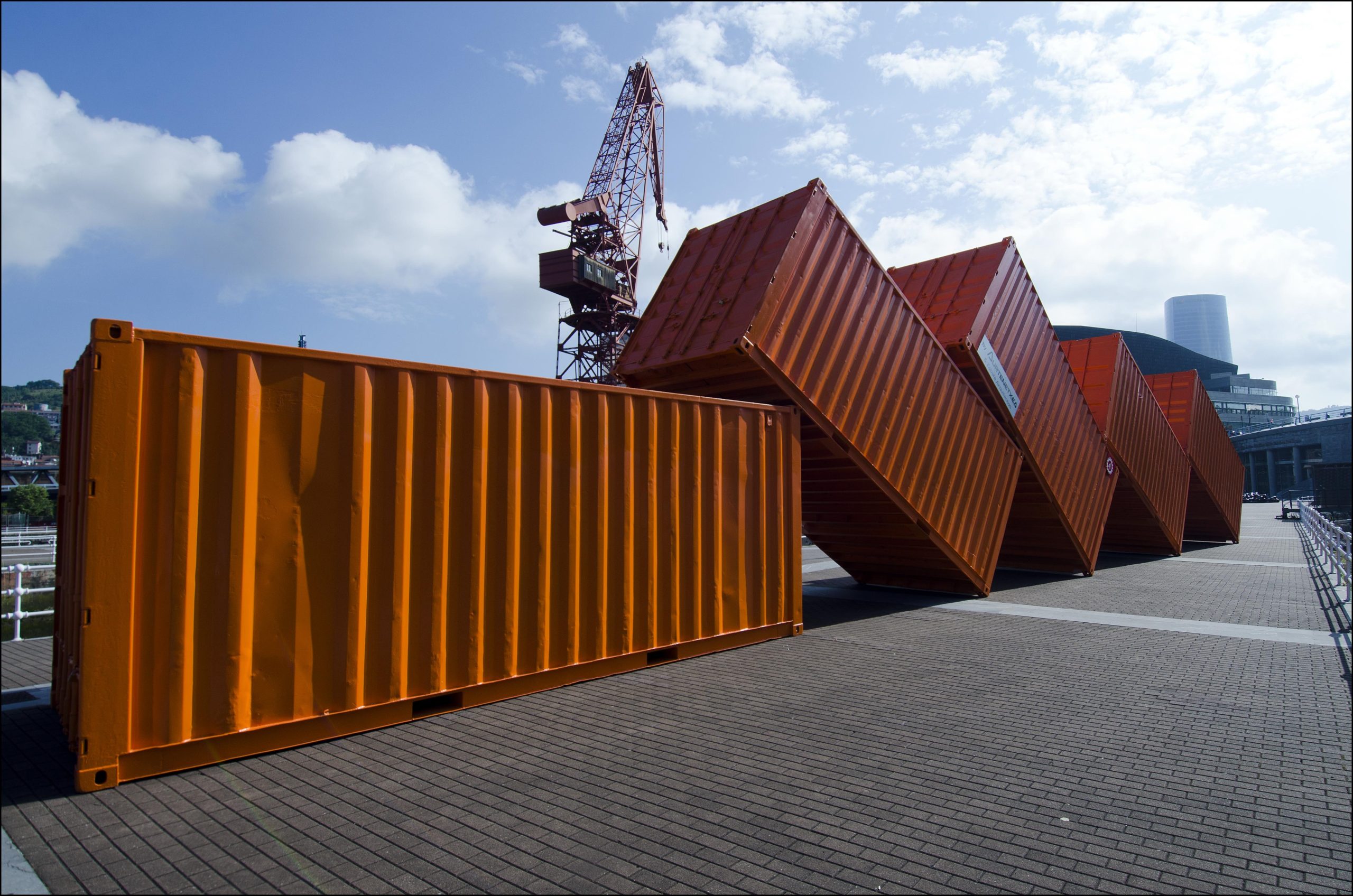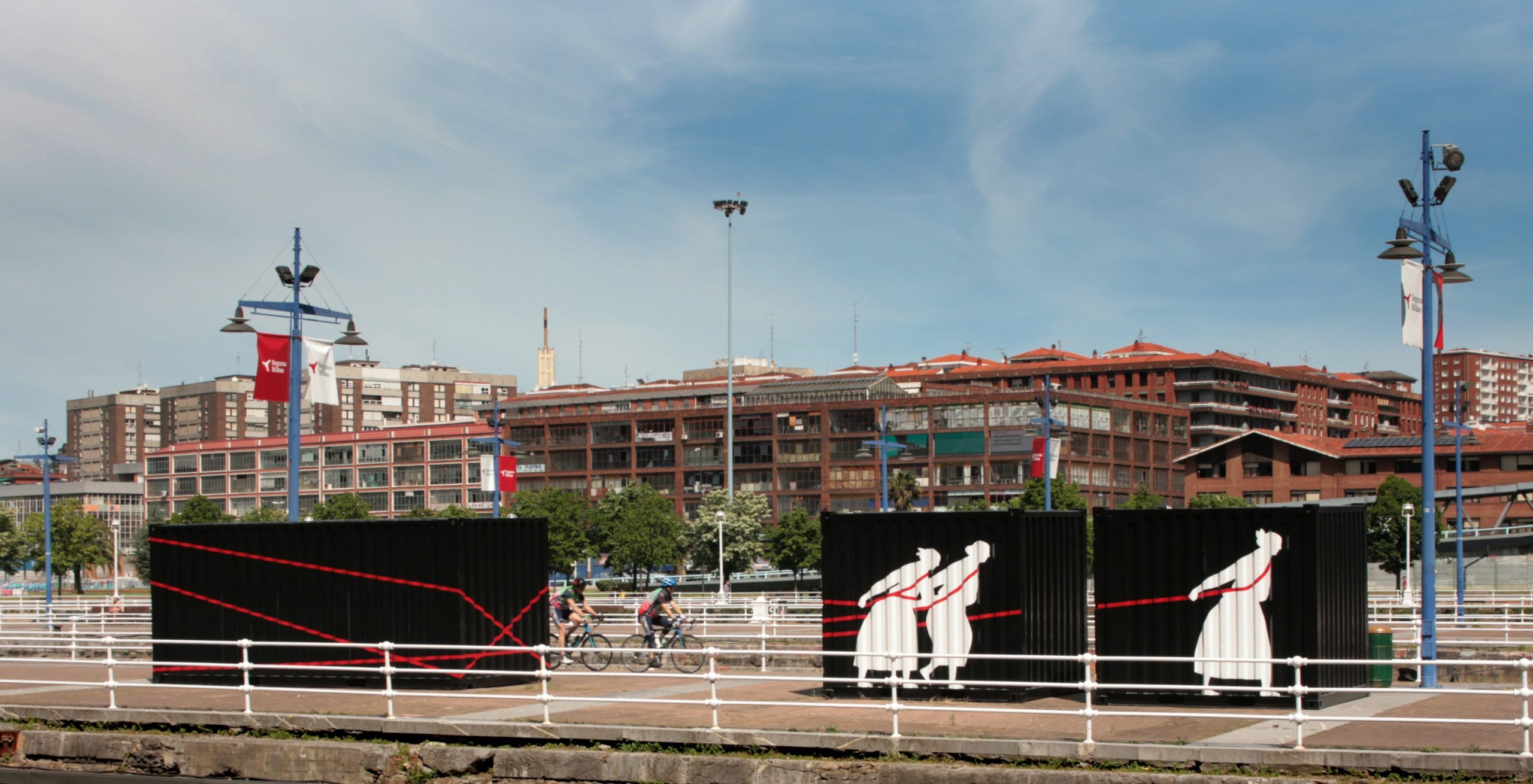
Description of the winning works of the ten editions of the Contest of Artistic Interventions on Containers

Presidium 1,2,3,4,5
Alberto Díez and Leo Burge
2013
Baluarte 1,2,3,4,5 was born as an ephemeral intervention in which standing containers would be demolished. However, the action never took place, and the work remained as a fixed structure, freezing in space the possibility of a movement that never happened, like the trace of an unfinished gesture.
The orange color of the containers was chosen for its contrast with the blue sky, making the work stand out in the urban landscape. Despite its rigid arrangement, the installation creates an unexpected meeting point for the public, generating an unusual clash between the everyday and a form that suggests play. In this sense, it acts as a barrier on the esplanade, surrounded by predefined constructions.
ALL IRON
Sea of God / Miguel de Puertas
2014
ALL IRON is a tribute to the boom years during industrialization in Bilbao, a key era that laid the foundations for the expansion of what we know today as Greater Bilbao. It is said that, in one of the English companies dedicated to the exploitation of iron in Bizkaia, when the extracted iron ore reached its maximum purity, the English boss hung a sign with the words «ALL IRON». Despite the long hours, harsh conditions and meager wages, for the workers this was a cause for celebration, as their pay was doubled. At that moment, everyone would sing in unison: «ALL IRON! ALL IRON!», a chant that would later become part of the anthem of the city’s soccer team.
CONTENT CONTENT
Juan Carlos Arango (Juan Malk)
2015
CONTENIDO CONTENIDO represents a plastic abstraction, in which the container suggests its contents, a metallic crate of a base color that refers to the rust so present in the maritime environment, alternating with a multitude of bright colors that contrast with the anonymity of a standard and impersonal shell, carrying countless desires. Industrial containers carry objects of all kinds, goods and supplies required for collective or individual development, and are the cold packaging of the longings of cities, factories or people.
This plastic game, together with the staggered surface of the container, creates an effect of vibration in the observer, producing an impression of vitality and movement, a mutability between the rigid container and a gift box.
PAPEREZKO ITSASONTZIA
Alvaro Aroca
2016
Paperezko Itsasontzia explores the reconstruction of an evocative, drifting journey through a geometric figure emerging from three containers. These iron structures evoke a paper boat that sails driven by memories. In its center, emptiness takes center stage, delineating a space of reflection and memory that invites us to contemplate and look beyond the visible. The emptiness, essential in this composition, reinforces the fragility of the boat and its double materiality: iron becomes paper, and paper becomes iron, symbolizing the connection between the ephemeral and the permanent. Along the Bilbao estuary, viewers are invited to reconstruct their own journey, immersing themselves in a dialogue with the material and the intangible, as this metallic paper boat sails towards the imaginary.

THE PATH OF THE TOWROPE
María de Viana / Xabier Dobaran
2017
El Camino de la Sirga refers to the margins of the estuary, and to the hard port labor of the sirgueras. A grueling activity carried out by groups of women, consisting of towing heavy boats for the transport of goods from the shores by hand, using ropes tied to their bodies. Their effort, closer to that of beasts of burden than to the principles of labor equality that were beginning to take shape in the society of the late 19th century, was maintained until the first decade of the 20th century.
The work represents the figure of three women (sirgueras) slightly oversized, towing a large load symbolized through a container. The action of «pulling the towrope» creates a visual metaphor that pays tribute to all the people who, with their collective effort, contributed to the growth of Bilbao.
PLASTIKOZKO ITSASOAK
María Acuña
2018
Plastikozko Itsasoak seeks to make visible the amount of plastic that accumulates in the Bilbao estuary which, if not removed, will end up affecting our coasts as well, putting marine fauna at risk. The artist invites us to reflect on the impact that a simple plastic bag can have on the marine ecosystem, highlighting the urgency of taking measures for its protection.
The work presents the figure of a rorqual whale, fragmented, with a cavity that reveals plastic remains, as if it were the stomach of the cetacean. This waste, collected by Acuña directly from the estuary, symbolizes a worrying reality: the ingestion of plastic is one of the main causes of death of numerous marine animals.
In our guts we carry the suffocating burden of your lifestyle.